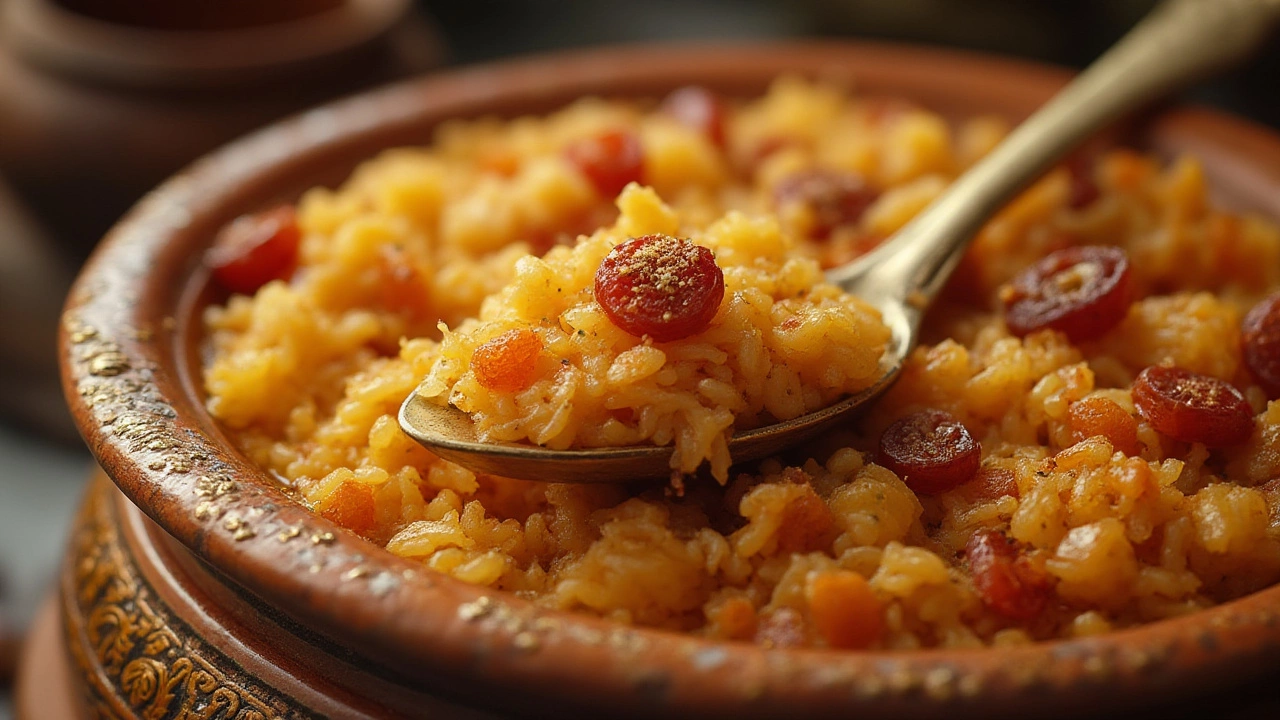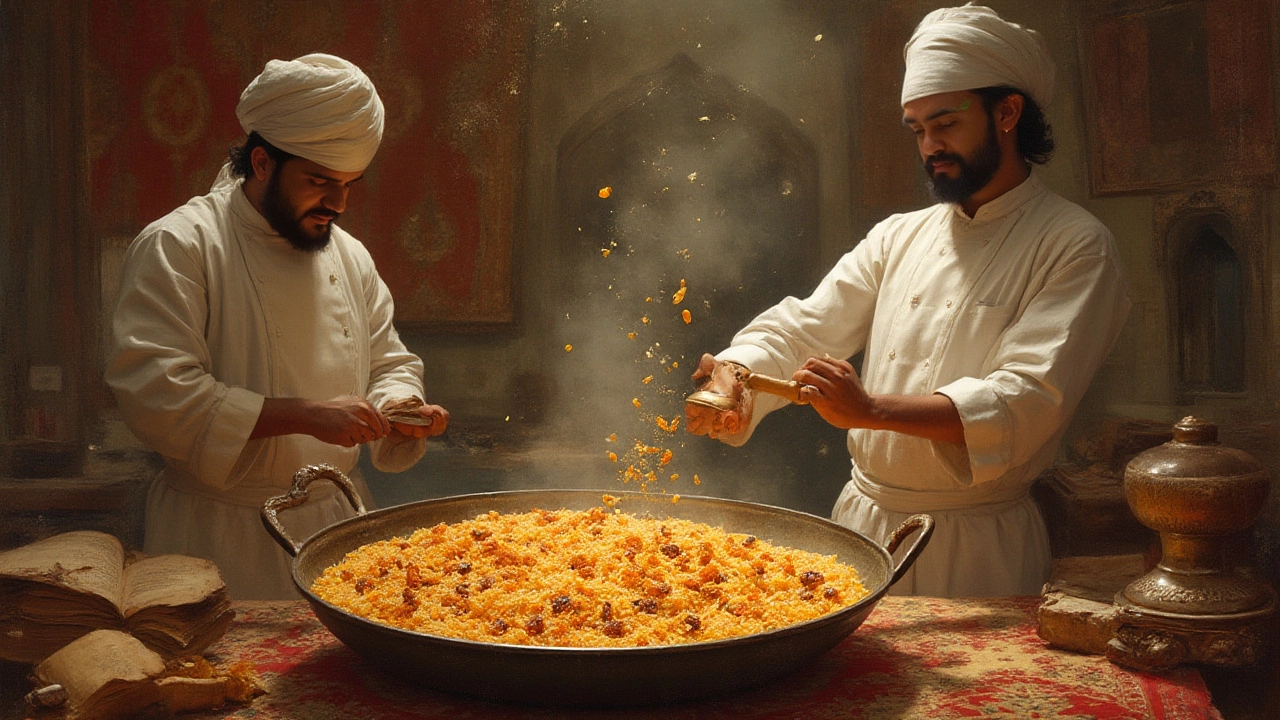Biryani isn’t just a meal. It messes with your tastebuds—a little fire here, a hint of muskiness there, and then suddenly, a tiny spark of sweetness that makes you look down at your plate in happy confusion. Maybe you thought it was a rogue raisin, or a bit of caramelized onion, or some mysterious bit that slipped from the chef’s magic fingers. Honestly, that little sweet bite is often the part people remember the most, especially for anyone hunting through their rice, searching for more. Ask any veteran biryani eater in Bristol (like my husband Arjun, who is obsessed with uncovering every ‘secret’ to good biryani), and you’ll hear stories of accidental discoveries: someone biting into a cashew toasted in ghee, or someone else finding a plump golden sultana among the masala. It’s these surprises that keep biryani lovers guessing and always wanting a second helping.
The Mysterious Sweet Thing: What Is It Really?
The sweet thing in biryani is rarely just one ingredient—it’s more of a collective surprise. In classic North Indian, Hyderabadi, Kolkata, or even Sri Lankan biryanis, that sweet note often comes from dried fruits like raisins (sometimes sultanas), prunes, dates, or slivers of apricot. These aren’t just added for their taste. The dried fruit works double duty, absorbing some of the spices and then releasing a mellow, sweet punch when you bite into them. They also add interest for your tongue, which is already reeling from all the bold flavors of clove, cardamom, and cinnamon. Some skilled home cooks even soak raisins in warm water or a little rose water before adding to biryani, making them extra juicy and fragrant. But dried fruits aren’t alone in this department. Caramelized onions, also called birista, are another frequent culprit. Thinly sliced onions are slow-fried in oil until deep brown, then sprinkled between layers for that unique crunchy-sweet pop. They even have a science-y name for it—the Maillard reaction, which transforms the onions’ natural sugars and amino acids into rich, satisfying flavors. And sometimes, you’ll even run into a stray chunk of candied fruit, known as tutti frutti in some East Indian biryanis, though that’s more common in festive versions.
Sweet Ingredients from Around India: Regional Variations
Every region, and sometimes every family, has a signature way of twisting biryani’s flavor. For instance, in Lucknowi biryani, sultanas and cashews are classic. Hyderabadi biryani lovers swear by fried golden onions, and might sneak in a few raisins for good luck. Travel to the coast, and in Kolkata biryani, you’ll find prunes (yes, actual prunes!) meant to mimic Mughal richness, paired with boiled potatoes for another sweet undercurrent. On wedding tables in Kerala, it’s not rare to find biryani flecked with small pieces of dried dates or figs. Even Sindhi biryani, famous for its extra spice, sometimes features little bursts of sweetness from dried plums. Here’s something interesting: in one home-cooked feast I attended in Bristol (hosted by a Pakistani neighbor who makes a mean biryani), he swore by soaking his golden raisins in saffron-infused water for thirty minutes before tossing them into the rice, boosting both the color and the flavor. Besides, some cooks get cheeky and add a dusting of sugar or jaggery during the final steam, just to take the edge off spice if they’ve accidentally gone a bit wild with the chili. You won’t find that tip in most recipe books, but ask any auntie and she’ll probably admit to it!

Why Add Sweetness? The Science and Tradition
Biryani isn’t just about layering ingredients—there’s real chemistry happening every time a pot is sealed. When heat hits those dried fruits and onions, their sugars break down, creating soft, caramel-like flavors. Paired with protein (like chicken, lamb, or even paneer), this sweetness balances the heat and helps mellow intense spices. Honestly, it keeps you from reaching for a glass of water after every bite. Sweetness in biryani isn’t just a matter of taste, though. It’s rooted in centuries-old Persian, Mughal, and South Asian cooking, where cooks learned that a splash of sweet cools things down and unifies strong flavors. In old Lucknow or Hyderabad, the chefs in royal kitchens used sweet components as a sign of luxury—a little dried fruit showed you could afford imported, special ingredients. Even today, sweets in a biryani set it apart as festive or worthy of guests. If you look at ingredient lists for biryani on packaging outside the UK’s South Asian stores, you’ll notice they always mention things like ‘kismis’ (raisins), ‘meetha’ (sweet), or other dried fruit. Science backs all of this up, too. A 2023 study on flavor balance in South Asian rice dishes (published in the Journal of Culinary Science & Technology) found that a ratio of 4:1 of savory to sweet elements made biryani more enjoyable for 65% of participants. Too much sweet? Overpowering and cloying. Too little? Harsh and one-note. That’s why a handful is always enough.
Fun Facts and Hidden Sweet Add-Ins
It isn’t just dried fruit and onions. Some biryani recipes have a few surprises lurking under those rice layers. During religious festivals or weddings, you may find chunks of candied fruit (like Karachi biryani) or even slivers of caramelized carrot. South Indian thalassery biryani features dried currants and sometimes grated coconut, which gives a toasty sweetness once steamed. Believe me, if you’re ever in doubt, just check what’s sunk to the bottom of the pot after serving! There are even modern experiments popping up—last Eid, my friend tried adding dried cranberries to her chicken biryani for a tangy-sweet twist. They didn’t overpower the dish, but they did make everyone guess what that red jewel in their rice was. And don’t even get me started on the layered nut magic. Cashews and almonds, pan-toasted till golden, can trick you into thinking you’ve bitten into something almost dessert-like. Some families in Bengal also add a very thin layer of sweetened curd between rice layers during Dum (steam cooking) to give the biryani a silky, subtly sweet back note. Here’s a handy table of the most popular sweet ingredients found in regional biryanis:
| Region | Main Sweet Ingredient | Special Occasion |
|---|---|---|
| Lucknow | Sultanas, Cashews | Weddings, Festivals |
| Hyderabad | Fried Onions, Raisins | Daily, Eid |
| Kolkata | Prunes | Special Family Feasts |
| Kerala | Dates, Figs, Coconut | Weddings |
| Sindh | Dried Plums | Christmas, Ramadan |
Does every biryani have a sweet thing? Not always. But if you get one with dried berry or a bit of sweet nut hiding inside, that’s a sign you’re in the hands of someone who cares. Next time you get takeout from Bristol’s South Asian restaurant row, check your rice for those golden nuggets—you never know what you’ll find.

Tips for Adding the Sweet Thing at Home
So you want that perfect sweet burst in your homemade biryani—the one that’ll have your friends asking what your secret ingredient is? Here’s how I do it when Arjun is craving something close to home. First, always pick plump golden raisins—if they look dry, just soak them in a couple of tablespoons of warm water or rose water for about 10 minutes. Want an earthier, caramel edge? Fry chopped onions slowly on low heat, stirring often, until deep golden brown but not burnt. If you’re tossing in dried apricots or prunes, dice them small—it helps them blend into mouthfuls of rice rather than popping out sharply. For a dinner party flair, toast a handful of cashews or slivers of almond in a spoonful of ghee, and scatter them right before serving. If you want to go wild, sprinkle just a pinch of sugar between the final layers as you assemble—the rice will melt it down into everything, but don’t overdo it, or you’ll turn dinner into dessert! Be cautious with strong add-ins like tutti frutti or dried cranberries. They’re best for special occasions, as their flavor can easily overpower. If you’re after tradition, stick to sultanas and fried onions—the tried-and-tested combo that works every single time. And don’t forget the final layer of birista (fried onions)!
One more thing: always taste as you go. That’s the real secret to biryani, whether you’re in Bristol or Bangalore. Some days you might feel like pushing the sweet a little more. Other days, you’ll want to let the savoriness sing. Biryani is forgiving and flexible—just don’t forget to sneak a couple of those sweet bites for yourself before the pot gets cleaned out!
